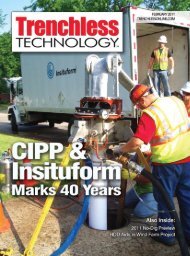Author: Professor, Dr. Dietrich Stein - TrenchlessOnline
Author: Professor, Dr. Dietrich Stein - TrenchlessOnline
Author: Professor, Dr. Dietrich Stein - TrenchlessOnline
You also want an ePaper? Increase the reach of your titles
YUMPU automatically turns print PDFs into web optimized ePapers that Google loves.
INDUSTRY WATCH<br />
Aging Infrastructure Must Be Fixed Sooner, Not Later<br />
By Katherine Fulton<br />
“In the past 50 years or so, engineering has made great<br />
advances,” says Bill Marcuson, president of the American<br />
Society of Civil Engineers (ASCE).“Unfortunately, we often<br />
gain knowledge from our mistakes.”<br />
Sadly, these mistakes can sometimes take the form of fatal<br />
catastrophes. While some of these disasters occur despite<br />
vigilance and the best of intentions, many others are the<br />
result of poor maintenance or other preventable measures.<br />
Recently, two American cities had to contend with infrastructure<br />
failures that resulted not only in major damage to<br />
urban areas, but also to tragic losses of life. A steam pipe<br />
explosion in New York City on July 18, injured 45 and indirectly<br />
killed one (the victim suffered a heart attack while<br />
fleeing the scene). Less than a month later, the collapse of<br />
the I-35W Mississippi River bridge in Minneapolis, killed 13<br />
people when it plunged into the river.As crews pick up the<br />
pieces and investigators look into the causes of both accidents,<br />
many are wondering about the state of infrastructure<br />
in their area — and if leaders and decision-makers at all levels<br />
of government will do what it takes to prevent accidents<br />
like this from happening again.<br />
Though investigations into both the New York City and<br />
Minneapolis incidents are not yet conclusive, many agree that<br />
there could be several contributing factors that led to a “perfect<br />
storm” of sorts, resulting in the failure of these systems.<br />
Fabian Hadipriono Tan, a civil engineering professor at The<br />
Ohio State University,states that systemic failures are the result<br />
of either external causes,such as environmental stresses,pressure/wear<br />
on a structure,and so on,or internal causes,such as<br />
design, construction, material or maintenance errors.<br />
“External events are generally expected by us,” says Tan.<br />
“[In the case of the New York City steam pipe,] we normally<br />
have mechanisms like steam traps to relieve water pressure,<br />
to drain water that could create catastrophic events<br />
and so forth.We would also expect that regular and proper<br />
inspection and maintenance procedures be implemented<br />
on this type of infrastructure. External events are expected.<br />
“However, what we normally do not expect to happen<br />
here is what we call internal flaws, such as design errors,<br />
construction problems,material problems and maintenance<br />
of the pipes.We engineers design it and we assume that it is<br />
properly designed, so if there is an error, we don’t expect<br />
that error to happen. Otherwise, it’s not going to be<br />
installed in the first place.”<br />
While a combination of both external and internal causes<br />
could have easily sped the deterioration of these systems,<br />
the final piece of the puzzle could be issues with infrequent<br />
or improper maintenance at a time when funding for public<br />
systems continues to decrease.While no one will be able<br />
to pinpoint a definitive cause until after the investigations<br />
18 TRENCHLESS TECHNOLOGY September 2007 www.trenchlessonline.com








